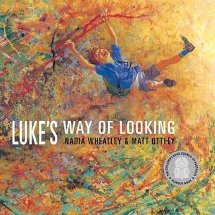Luke's way of looking by Nadia Wheatley

Ill. by Matt Ottley. Walker books, 2012. ISBN 9781 921977 72 5.
(Ages: All) Highly recommended. Picture book. Difference.
Walker Books has reprinted dozens of Australian classics, and this
is another superb publication, an award winner, which will intrigue
readers all over again, probably replacing an old well used copy on
the library shelves, while introducing it to younger teachers.
The story of Luke, derided by a teacher and some of the students for
his art which is not confined to the strictures of the teacher, has
huge appeal. There are all sorts of layers here to think about and
discuss: the issue of bullying, people's different ways of seeing
the same thing, imagination, individuality, being true to oneself
amongst others. Luke remains true to his own version of what he
sees, although he cannot explain it, eventually staying away from
school. On this day he visits the local art gallery, and sees for
the first time, the works of others who see things as he does.
Bolstered in his own individual way of seeing things, her returns to
school a much happier student, able to retain his individuality and
belief in himself.
Writing down what I feel about the book underlines to me even more
Nadia Wheatley's consummate skill at portraying Luke and his 'way of
looking' succinctly and precisely. The words I have used seem lame
compared with Wheatley's prose and the way each sentence is
constructed, having a particular place while promoting thought in
the overall story.
The illustrations are pure magic. The incredible image on the first
two pages of the overbearing teacher, his hand reflected largely on
the wall behind them, the group of boys almost cowering under his
influence leads the reader into his derision of Luke's artworks, the
small boy and his work minute under the teacher's looming form on
the next pages. Luke strays from school, taking the tram to the Art
Gallery where he sees things he has never seen before. Colour
becomes more important on each page as Luke's spirit is lifted, the
images themselves are joyous and positive, the people on the bus
home, welcoming and interested. Returning to school sees a return to
the sepia of the first few pages, but then Luke's colour takes over,
and it is the teacher whose image is reduced. The juxtaposition of
full page illustrations, smaller framed illustrations, the way the
print lies on the page, all add to the myriad of talking points this
wonderful book promotes. And this new edition provides editorial
comment from Dr Robyn Morrow, Nadia Wheatley and Matt Ottley, adding
another level of discussion for students, readers, parents and
teachers to digest, think about and consider.
Fran Knight